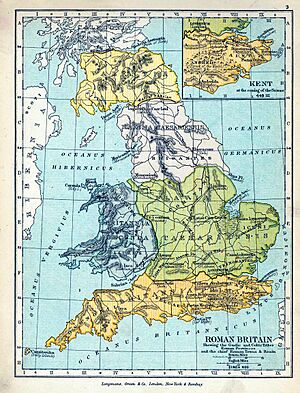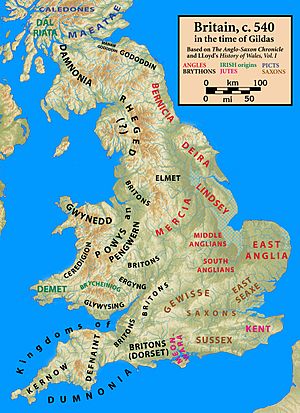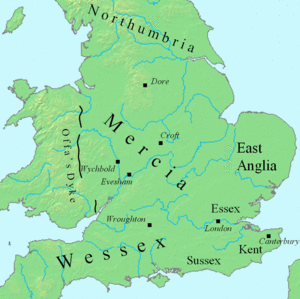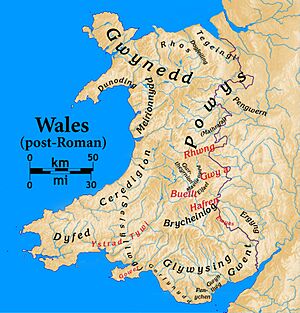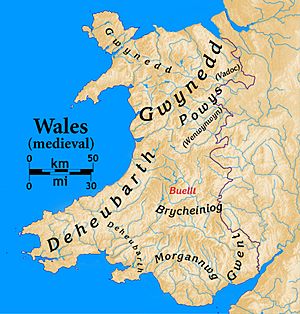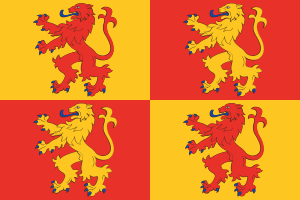List of Anglo-Welsh wars facts for kids
This list tells the story of wars and battles between two main groups in Britain: the Anglo-Saxons and the Britons. The Anglo-Saxons later became the English, and the Britons became known as the Welsh. These conflicts started around 446 AD, when the Anglo-Saxons first arrived in Britain. They continued until 1535, when England officially took over all of Wales. This list highlights the most important battles and campaigns from that long period.
Contents
- 5th Century Conflicts: Early Battles and King Arthur
- 6th Century Expansion: Anglo-Saxon Conquests
- 7th Century: Anglo-Saxon Dominance and British Resistance
- 8th Century: Defining Borders and British Victories
- 9th Century: Mercian Pressure and Viking Raids
- 10th Century: Peace and Major Battles
- 11th Century: United England and Norman Invasion of Wales
- 12th Century: Welsh Kingdoms Grow Stronger
- 13th Century: The End of Welsh Independence
- 14th Century: Stability and Rebellions
- 15th Century: Owain Glyndŵr's Uprising and Tudor Victory
- See also
5th Century Conflicts: Early Battles and King Arthur
In the 400s AD, Germanic tribes who followed pagan religions began to settle parts of eastern and southern Britain. These tribes, who became known as the Anglo-Saxons, attacked the Britons. The Anglo-Saxons called the Britons Wīelisċ, which meant "Welsh" or "foreigner." More Anglo-Saxon groups arrived from places like Old Saxony and Jutland. They often took over large areas of eastern and southeastern Britain through treaties or by force.
- The Germanic people living on the eastern "Saxon Shore" of Britain rebelled. This revolt was led by a leader named Hengest and his sons.
- Battle of Aylesford – The Anglo-Saxons, especially a group called the Jutes, defeated the Britons. This battle took place in Kent and was led by Hengest against the British leader Vortimer.
- Battle of Crayford – Hengest's Anglo-Saxons (Jutes) likely defeated the Britons again. This battle supposedly drove the Britons out of Kent. Hengest and his son Æsc then ruled Kent.
- Battle of Wippedesfleot – The Britons defeated the Anglo-Saxons (Jutes) in Kent. This victory forced the Anglo-Saxons back to the Isle of Thanet.
- The Anglo-Saxons (Jutes) later moved west and regained their land in Kent.
- Battle of Cymensora – Anglo-Saxons (Saxons) led by Ælle defeated the local Britons near Selsey.
- Siege of Anderida – Ælle's Anglo-Saxons (Saxons) captured Anderida Castle. They killed everyone inside, including men, women, and children. Ælle then created the Kingdom of the South Saxons (Sussex).
- Cerdic is said to have defeated the Britons near modern Bournemouth. He then established the kingdom of the West Saxons (Wessex).
Arthurian Battles: Legendary Victories
These battles are listed in an old text called the Historia Brittonum. They are said to have involved the legendary King Arthur.
- Battle on the River Glein – Arthur, a general for the British forces, and other British kings defeated the Anglo-Saxons.
- Second, third, and fourth battles at the river Dubglas in Linnuis – Arthur led the Britons to victory in these battles. Linnuis is thought to be the old Kingdom of Lindsey.
- Battle at the river Bassas – Arthur defeated the Anglo-Saxons.
- Battle in the Caledonian forest – Arthur supposedly defeated the Anglo-Saxons in Scotland.
- Battle of the fort (castellum) of Guinnion – Arthur defeated the Anglo-Saxons.
- Battle of "City of the Legion(s)" (urbs Legionis) – Arthur defeated the Anglo-Saxons. This city was probably Caerleon or Chester.
- Battle of the river shore of Tribruit – Arthur defeated the Anglo-Saxons.
- Battle of the hill of Breguoin – Arthur defeated the Anglo-Saxons. This battle is believed to have happened at Bremenium in Rochester, Northumberland.
- Battle of Mons Badonicus – The Britons, possibly led by King Arthur, soundly defeated the Anglo-Saxons. This major defeat is said to have stopped Saxon attacks for many decades.
6th Century Expansion: Anglo-Saxon Conquests
In the 500s, pagan Anglo-Saxon tribes conquered much of southern Britain. They captured important cities like London, Colchester, York, and Canterbury. Later in the century, a group called the Angles defeated the northern Britons. They then settled the northeastern coast.
- c.509 Battle of Natanleod – The West Saxons, possibly led by Cerdic, defeated the Britons at Netley, Hampshire.
- 519 Another battle where Cerdic was victorious. He is said to have established the Kingdom of Wessex around this time.
- 527 Battle of Cerdicesleag – The West Saxons, led by Cerdic and his son Cynric, defeated the Britons.
- 530 The Britons on the Isle of Wight were taken over by the Anglo-Saxons (Jutes).
- 547 The Northern Angles, led by Ida the Flamebearer, captured the fortress of Din Guyaroi. This was taken from the Britons of the Kingdom of Bryneich.
- c.550 This is the likely date for the fall of Londinium (London) and Camulodunum (Colchester) to the East Saxons.
- 575 A northern alliance of Britons, led by King Urien of Rheged, defeated the Angles of Bernicia. They then surrounded them on Ynys Metcaut for three days.
- 577 Battle of Deorham – The West Saxons and their allies captured a British fortress near Dyrham. The Britons of the Severn Valley tried to get it back but were defeated. Three of their kings were killed. The West Saxons then captured Gloucester, Cirencester, and Bath. This separated the Britons in the southwest from those in modern Wales.
- 580 Battle of Ebrauc – The Angles of Bernicia captured the city of Ebrauc (modern York).
- 584 Battle of Tintern – The armies of the Kingdom of Gwent, led by Tewdrig and his son Meurig, defeated the English. This forced the English to leave the Gloucester area. Tewdrig was badly wounded and died three days later.
- 590 The northern alliance of Britons was defeated. This happened after their leader was killed and the allies became divided.
- 598 Battle of Catraeth – The northern Angles, led by Æthelfrith, defeated the forces of the Britons of Gododdin and Bryneich (Bernicia).
7th Century: Anglo-Saxon Dominance and British Resistance
In the 600s, the Anglo-Saxons strengthened their control over southern and eastern Britain. The Mercian Angles made big gains in central Britain, now known as the English Midlands. Wales (Cambria) became cut off from other British groups in the northwest and southwest. By the middle of the century, the Anglo-Saxons had converted to Christianity. The last serious attempts by the Britons to reclaim Britain failed.
- 614 Battle of Beandun – The West Saxons, led by Cynegils, defeated the West Britons. This battle was possibly led by Tewdwr ap Peredur at Badbury Rings, Dorset. Over two thousand British warriors may have died after the fort was captured. Dorset might have been taken by Wessex after this battle.
- 616 Battle of Chester – The Northern Angles of Northumbria, led by Aethelfrith of Northumbria, defeated an alliance of Powys and Gwynedd. They then captured the city of Chester.
- 619 The united Northumbrian Angles, led by Edwin of Northumbria, invaded and conquered Elmet. Elmet was a British territory near modern Leeds. The Kingdom of Elmet was taken over, and its last ruler, Ceretic, was forced to leave. He died soon after in Powys.
- 629 The Northumbrians invaded Gwynedd and forced Cadwallon ap Cadfan to leave.
- 630 The Battle of Pont y Saeson – Tewdrig, King of Gwent, and Meurig defeated the invading Saxons.
- 630 The Battle of Cefn Digoll, also called the Battle of the Long Mynd, was fought near Welshpool. The British won this battle.
- 633 Battle of Hatfield Chase – This battle near Doncaster was fought between King Edwin's Northumbrian army and an alliance. This alliance was between King Cadwallon of Gwynedd and Penda of Mercia. Edwin was killed, and the Northumbrian invaders were driven out of Gwynedd. Cadwallon then occupied Northumbria, capturing York.
- 634 Battle of Heavenfield – Cadwallon was defeated and killed by the Northumbrians, led by Oswald of Northumbria, near Hadrian's Wall. The British were driven from Northumbria, ending their attempt to reclaim the North.
- 638 The Britons of Gododdin, in the modern Edinburgh area, were defeated at (Catraeth).
- 642 Battle of Maes Cogwy – The British and their Mercian allies were defeated by the Northumbrians near Oswestry.
- 650 Battle of Bradford on Avon – A West Saxon victory against the West British.
- 655 Battle of the Winwaed – King Oswiu of Bernicia defeated and killed King Penda of Mercia. King Cadafael ap Cynfeddw of Gwynedd was allied with Penda but did not fight in the battle.
- 658 The small British kingdom of Pengwern in modern Shropshire was taken over by Mercia.
- 658 Battle of Peonnum – An allied force of West British and Cadwaladr of Gwynedd was defeated in Somerset. The West Saxons then moved to occupy western Somerset.
- 665 The alleged Second Battle of Badon – This was supposedly a West Saxon victory against the Kingdom of Gwent and its allies.
- 670 The West Saxons, led by Cenwealh, captured central Somerset. They established a religious center at Glastonbury.
- 682 The West Saxons, led by Centwine, moved west. They defeated the West British near the River Parrett, supposedly driving them "to the sea."
- c.685 The Brut y Tywysogion (a Welsh chronicle) records a British victory in the southwest. This victory, with naval support from allies in Brittany, forced the West Saxons back from some of their gains.
8th Century: Defining Borders and British Victories
In the 700s, the British territories in the southwest (now Cornwall and much of Devon) defended themselves. They even pushed the English back. The borders of modern Wales were mostly set as Mercian expansion slowed down.
- 710 After defeating the West British of Devon, led by Geraint of Dumnonia, Ine of Wessex built a fortress at Taunton. This was to defend his lands. King Geraint was killed in the battle.
- c.720 Battle of Hehil – In Dumnonia, the Cornish British, with help from Rhodri Molwynog, won against Wessex. This brought peace to Cornwall for almost a century. The Brut also records another battle won by Rhodri against the Saxons.
- c.720 The Battle of Pencoed in Morgannwg, the Battle of Garth Maelog, and "another battle in Gwynedd" are listed as British victories.
- 722 Ine of Wessex advanced to the River Tamar but was defeated and retreated. The West Saxon fortress at Taunton was destroyed.
- 728 Battle of Carno Mountain – In Gwent, the British drove the Anglo-Saxons back to the River Usk. Many Anglo-Saxons drowned there.
- 733 Battle of Devawdan – Another British victory.
- 735 First Battle of Hereford – The British won after a long and bloody fight.
- 743 An allied army of Mercians and West Saxons fought the British. This might have led to the building of Wat's Dyke.
- 752 Eadberht of Northumbria invaded the Kingdom of Strathclyde and conquered Kyle.
- 753 The West Saxons, led by Cuthred, fought the British of Cornwall. The result is not known, but the Cornish kept their independence, suggesting a Cornish British victory.
- 755 The westward expansion of Wessex continued. Over the next 30 years, Wessex controlled eastern and northern Devon.
- 756 The Northumbrians, led by Eadbert, allied with the Picts. They invaded the northern British Kingdom of Strathclyde and defeated their king Dumnagual. He was forced to submit and became a vassal of Northumbria for a while. A second battle at Hereford is recorded as another British victory in the Brut y Tywysogion.
- 765 The British invaded Mercia and caused much damage.
- 769 Mercians campaigned in Wales.
- 760 Battle of Hereford – Recorded as a British victory against the Mercians, led by Offa of Mercia. The British were likely led by Elisedd ap Gwylog of Powys and his son Brochfael ap Elisedd.
- 780 The building of Offa's Dyke began. This ditch likely marked an agreed border between Powys and Mercia.
- 784 It is thought that Exeter was captured by Cynewulf of Wessex after a siege. The British invaded Mercia again, causing problems.
- 798 The Mercians, led by Coenwulf of Mercia, invaded Wales but later retreated. Their forces killed the Welsh King Caradog ap Meirion.
9th Century: Mercian Pressure and Viking Raids
In the first half of the 800s, a stronger Mercia almost conquered the rest of Wales. By the end of the century, Viking raids on England shifted some attention away from the British.
- 815 Egbert of Wessex invaded Cornwall and took control of the kingdom. 820 has also been suggested as a possible date for this "invasion."
- 816 Mercians invaded Powys.
- 822 Coelwulf of Mercia invaded north Wales. He captured Deganwy from Gwynedd and occupied all of Powys.
- 825 Battle of Camelford – A battle between Wessex and the Cornish British, resulting in a West Saxon victory.
- 828 The lands of Powys were freed from Mercian control by Cyngen ap Cadell. The Pillar of Eliseg was likely built around this time.
- 830 Egbert of Wessex invaded Powys and made a treaty with Cyngen ap Cadell. Egbert then withdrew his forces.
- 838 Battle of Hingston Down – In Cornwall, a combined force of Cornish and Danes was defeated by the larger army of Wessex.
- 853 Burgred of Mercia took over Powys. Cyngan ap Cadell gave up his throne and went to Rome. His kingdom was then taken by Rhodri Mawr of Gwynedd.
- 865 Burgred of Mercia led his forces against Rhodri Mawr. He briefly captured Anglesey from Gwynedd. Burgred was later driven out, and his kingdom was invaded by the Vikings.
- 878 The British of Strathclyde, allied with Kenneth MacAlpin, invaded northern Northumbria. Northumbria was fighting the Vikings at the time. The British liberated the Lothian region.
- 881 Battle of the Conwy – A Welsh victory against the Kingdom of Mercia.
- 890 At least some of the "men of Strathclyde" were forced to move to Gwynedd. Their kingdom, weakened by the Vikings, was taken over by Angles and Scots.
10th Century: Peace and Major Battles
This was a time of relative peace. Hywel Dda came to rule most of Wales and formed an alliance with Wessex. This alliance was against the Vikings, who had weakened Mercia.
- 925 King Athelstan of England drove the Cornish out of Exeter. He then took control of Cornwall and set the border with England at the River Tamar.
- 937 The Battle of Brunanburh – Also known as "the Great War," this was supposedly the bloodiest battle ever fought in Britain. Five kings reportedly died. The Anglo-Saxon King Ethelstan and his brother Edmund, with allies, defeated the armies of Olaf III Guthfrithson (Norse-Gael King of Dublin), Constantine II (King of Alba), and Owen I (King of British Strathclyde). This battle was very important, and some say it marked "the moment when Englishness came of age." Modern experts believe the battle took place at Bromborough on the Wirral Peninsula.
- 940 Idwal Foel of Gwynedd invaded England. He was driven back and later lost his lands.
- 945 After an English invasion of the Kingdom of the Cumbrians, the English king supposedly gave part of it to the Scottish king. How much power the Scots had over the Cumbrians is unclear.
- 962 King Edgar the Peaceful invaded Gwynedd.
- 985 Hywel ap Ieuaf of Gwynedd was killed fighting Ælfhere, Ealdorman of Mercia.
11th Century: United England and Norman Invasion of Wales
A united kingdom of England was formed. The Welsh were united for a time under Gruffudd ap Llywelyn. However, he was killed in new internal conflicts before the Norman Conquest of England. The new Norman rulers of England then began to invade Wales, damaging parts of the Welsh kingdoms.
- 1039 Battle of Rhyd y Groes – Gruffudd ap Llywelyn, the new King of Gwynedd, ambushed a Mercian army led by Leofric of Mercia in Brycheiniog, destroying them.
- 1052 Gruffudd ap Llywelyn invaded Herefordshire and attacked Leominster.
- 1055 Gruffudd ap Llywelyn allied with the exiled Ælfgar, Earl of Mercia and attacked Herefordshire.
- 1062 Harold Godwinson, the Earl of Wessex, and his brother Tostig began campaigns against Gruffudd ap Llywelyn. This was in response to years of border raids. Gruffudd was killed.
- 1067 Bleddyn and Rhiwallon ap Cynfyn, co-rulers of Gwynedd, invaded Herefordshire. They supported Eadric the Wild, an English rebel fighting the Norman Conquest of England.
- 1067 After conquering England, the Norman rulers invaded the Kingdom of Gwent. They forced King Caradog ap Gruffudd to leave.
- 1073 The Normans invaded Gwynedd and occupied Arfon.
- 1085 The Normans launched a full invasion of Gwynedd and Powys.
- 1091 The Normans took some lowlands of the kingdom of Morgannwg. They forced Iestyn ap Gwrgan to leave.
- 1093 The Normans and their English subjects advanced into Brycheiniog. They killed Rhys ap Tewdwr, the king of Deheubarth.
- 1094 Aber Llech – This was the peak of a Welsh uprising. It drove the Normans back into England, except for a few castles. Deheubarth gained land from other southern kingdoms.
- 1095 The Normans returned but could not get the Welsh to fight a big battle.
- 1098 The Normans occupied Gwynedd and Anglesey. They left within the year.
12th Century: Welsh Kingdoms Grow Stronger
Civil wars among the Norman lords in England gave the Welsh kingdoms a chance to become stronger. By the end of the century, a powerful Gwynedd expanded its lands at the expense of its neighbors.
- 1116 The Welsh of Deheubarth rebelled against the Norman invaders.
- 1134 Welsh raids into Shropshire destroyed Caus Castle.
- 1136 The Welsh rose up against the Norman forces. They drove them from all of Wales except the Lordship of Carmarthen. This included the Battles of Llwchwr (January) and Crug Mawr (October).
- 1137 An army from Gwynedd captured Carmarthen from the Norman invaders.
- 1144 The Marcher lord Hugh de Mortimer retook Maelienydd.
- 1145 Gilbert de Clare rebuilt Carmarthen Castle.
- 1149 Madog ap Maredudd advanced into Shropshire and added Oswestry to the kingdom of Powys. He held it until 1157.
- 1157 Henry II led a huge invasion to push Owain ap Gruffudd, the true king of Gwynedd, away from the border of Cheshire. After a failed landing on Anglesey, Henry II and Owain made an agreement. Owain agreed to retreat to the west bank of the River Clwyd.
- 1159 Rhys ap Gruffudd of Deheubarth attacked Anglo-Norman castles and settlements in south Wales. He captured Llandovery in 1162.
- 1163 Henry II launched a military campaign in south Wales, invading Deheubarth. He captured Rhys ap Gruffudd at Pencader and took him to England. Rhys got his lands back in 1164 after agreeing to show loyalty to Henry.
- 1165 Rhys ap Gruffudd led attacks on Anglo-Norman strongholds in south and west Wales. Gwynedd, Powys, Deheubarth, and smaller kingdoms formed an alliance against England. Henry II declared war and led an invasion force from Shrewsbury through Powys and into Gwynedd. Henry was forced to retreat, supposedly because of bad weather.
- 1166 Rhys ap Gruffudd captured Cardigan Castle from the Norman crown.
- 1167 Owain ap Gruffudd captured Rhuddlan Castle and Basingwerk. He advanced as far east as the River Dee.
- 1185 Welsh raiders attacked Cardiff.
- 1196 Full-scale war started again. Hubert Walter invaded Powys from Shrewsbury and surrounded Welshpool.
- 1198 Battle of Painscastle – A Welsh army was defeated by the Normans.
13th Century: The End of Welsh Independence
Gwynedd remained the most powerful Welsh kingdom until the mid-1200s. A "Principality of Wales" was declared by Llywelyn Fawr. After some chaos following the death of Llywelyn's successor, Dafydd ap Llywelyn, Dafydd's nephew Llywelyn ap Gruffudd became a major force. He took the title Prince of Wales in 1258 and established his power in Powys and Deheubarth. Llywelyn's death in 1282, and the capture and execution of his brother Dafydd ap Gruffudd in 1283, marked the end of Welsh independence. Wales was then taken over by England.

Pura Wallia (independent Wales) Lands gained by Llywelyn the Great in 1234 Marchia Wallia (lands ruled by the Marcher barons)
- 1211 The Welsh uprising began. King John of England invaded Gwynedd from Chester but had to retreat. A second invasion later that year, from Shrewsbury, left Bangor in ruins. John forced the prince of Gwynedd, Llywelyn Fawr, to surrender. Llywelyn agreed to give the Perfeddwlad to the English Crown.
- 1215 Llywelyn Fawr, allied with other princes, attacked English holdings across Wales. They captured Cardigan Castle, Carmarthen Castle, Kidwelly Castle, and many other places. At a Welsh meeting in 1216, Llywelyn was recognized as Prince of Wales by the noblemen of Powys and Deheubarth. Fighting ended in 1218 after a peace deal with England.
- 1223 Marcher lord Hubert de Burgh began campaigns. He retook Carmarthen, Cardigan, and Montgomery.
- 1240 After Llywelyn Fawr died, the English attacked. Marcher lords retook the lands Llywelyn had gained.
- 1241 Henry III invaded Wales. Dafydd ap Llywelyn was forced to surrender in August. The peace agreement, the Treaty of Gwerneigron, meant the English occupied the Perfeddwlad.
- 1244 Dafydd declared war. Several Welsh raids were made on the Wales-England border.
- 1245 Dafydd's war grew more intense. Gwynedd and its allies in Deheubarth and Powys Fadog made few gains in mid-Wales. However, Mold was recaptured by the Welsh in March. In August, the English attacked Gwynedd from Chester. They were defeated by Dafydd in battle. The invasion force reached Deganwy, where Henry was stopped after heavy fighting. In the autumn, a truce was agreed, and the English army withdrew. Dafydd's death in 1246 led to a new attack on Gwynedd from the south by Marcher lord Nicholas de Molis. This forced Deheubarth and then Gwynedd to surrender. Under the Treaty of Woodstock, Gwynedd withdrew from Perfeddwlad.
- 1256 Gwynedd, led by Llywelyn ap Gruffudd, grandson of Llywelyn Fawr, invaded and took over the Perfeddwlad. Gwynedd also took Brycheiniog, Maelienydd, Gwrtheyrnion, and Builth in the late 1250s. To prevent more English invasions, Llywelyn agreed to the Treaty of Montgomery (1267). He was recognized as the Prince of Wales. Deheubarth gained land in the south.
- 1277 Edward I declared Llywelyn ap Gruffydd a rebel. He invaded Wales, starting the First War of Welsh Independence. English armies from Carmarthen defeated the princes of Deheubarth. Armies from Chester took over Powys Fadog. Armies from Shrewsbury retook Maelienydd, Builth, Brycheiniog, and Gwrtheyrnion. In the Treaty of Aberconwy, Edward forced Llywelyn to give up control of all of Wales except Gwynedd west of the River Conwy. Powys Fadog and Deheubarth were broken up.
- 1282 Dafydd ap Gruffudd, Llywelyn's younger brother, who had previously worked with King Edward I, started a rebellion against England. Llywelyn eventually joined the conflict.
- 1282 The English invaded Wales under Edward I. In June, the Battle of Llandeilo saw the Welsh defeat an English army in the south. However, Edward's forces slowly advanced. In November, the Battle of Moel-y-don saw the Welsh decisively defeat an English invasion across the Menai Straits. In the Battle of Orewin Bridge (December 11), English forces killed and then beheaded Llywelyn ap Gruffydd in a surprise attack at Cilmeri. Dafydd ap Gruffudd became his successor.
- 1283 King Edward's forces captured the remaining castles in Gwynedd. The Welsh royal court hid in the mountains. English forces captured Dafydd ap Gruffudd in June. King Edward executed him in Shrewsbury in October, completing his conquest of Wales. The resulting agreements left only Powys Wenwynwyn, Edeirnion, Glyndyfrdwy, and Dryslwyn Castle under native Welsh rule, as clients of the king.
- 1287 Rhys ap Maredudd of Dryslwyn, a prince of Deheubarth, was angry about how Edward I treated him. He had supported Edward before. Rhys led attacks on English holdings in the south. He took back the Deheubarth royal center at Dinefwr and captured the Ystrad Tywi. By 1288, he had lost all his lands but remained a guerilla leader until his capture and execution in 1292.
- 1294 A Welsh uprising led by Madog ap Llywelyn swept through north and central Wales. Madog was a junior member of the House of Aberffraw. Rebels briefly captured Castell y Bere, Carnarvon Castle, Cardigan Castle, Dinas Bran, and Denbigh Castle. Madog declared himself Prince of Wales.
- 1295 Battle of Maes Moydog (March 5) – Madog was defeated, and the Welsh army was destroyed. Madog was soon captured and imprisoned.
14th Century: Stability and Rebellions
This was a period of relative peace under English rule. However, it was broken by two important revolts.
- 1314 A revolt broke out in Glamorgan.
- 1316 An uprising in Gwent and Morgannwg was led by Llywelyn Bren. He was the lord of Senghennydd and a descendant of the kings of Morgannwg. Rebels surrounded Caerphilly Castle for six weeks and burned the town. Bren's forces were defeated, and he was captured and executed.
- 1326 King Edward II was captured by rebels at Pantybrad after fleeing to South Wales.
- 1345 An uprising in Gwynedd was known as the Saint Valentine's Day Massacre. Henry de Shaldeforde, the king of England's attorney, and his men were ambushed and killed by Welsh rebels. Anti-English riots had started earlier in 1344, centered at Rhuddlan.
- 1369 Owain Lawgoch tried to invade Wales but failed.
- 1372 Owain Lawgoch announced his plan to claim the throne of Wales. He and his forces arrived in Guernsey.
- 1377 Owain Lawgoch planned another invasion with help from Castile. This led the English to send an assassin after Owain. Owain was killed in 1378.
15th Century: Owain Glyndŵr's Uprising and Tudor Victory
Civil conflict in England and the removal of Richard II set the stage for a national uprising. This revolt was led by Owain Glyndŵr, who successfully freed all of Wales from English control for a time. He was eventually defeated, and English rule was re-established in Wales.
- 1400 The Welsh Revolt began in Powys Fadog. It was led by Owain Glyndŵr, a nobleman from the house of Powys. Owain declared himself Prince of Wales in September and raided towns in northeast Wales. After a few months, the revolt spread across Gwynedd.
- 1401 Conwy Castle was captured by Owain's men. The Battle of Tuthill ended without a clear winner during a siege of Caernarfon Castle.
- 1402 Battle of Bryn Glas – Owain defeated the English, led by Marcher lord Edmund Mortimer. Mortimer was captured and later allied with Owain. The English were driven from Wales.
- 1405 The English launched multiple attacks on Wales, retaking many captured castles. In August, Owain led a combined French-Welsh army into England. They reached Woodbury Hill before retreating.
- 1409 Harlech Castle, Owain's last stronghold, fell to the English. Edmund Mortimer was killed. Owain led guerilla raids across Wales and was never captured. He is believed to have died around 1415. Maredudd ab Owain Glyndŵr accepted a royal pardon in 1421.
- 1485 Battle of Bosworth Field – Henry Tudor of the Welsh Tudor family became King of England. His family had fought alongside Owain during the second war for independence. With help from Welsh, French, and English troops, Henry defeated Richard III. Henry was a Welsh king who combined his Welsh and English kingdoms. He used the title Prince of Wales for his heir to gain the loyalty of his Welsh countrymen.
See also


